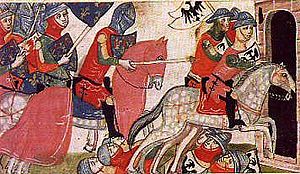
Back Batalla de Benavent AN معركة بينيفنتو Arabic Битка при Беневенто (1266) Bulgarian Batalla de Benevent Catalan Bitva u Beneventa (1266) Czech Schlacht bei Benevent German Batalla de Benevento (1266) Spanish Bataille de Bénévent French Batalla de Benevento (1266) Galician Beneventói csata Hungarian
| Battle of Benevento | |||||||
|---|---|---|---|---|---|---|---|
 Battle of Benevento, from Giovanni Villani's Nuova Cronica | |||||||
| |||||||
| Belligerents | |||||||
| Commanders and leaders | |||||||
|
| ||||||
| Strength | |||||||
|
12,000 men[1]
|
13,500–14,000 men
| ||||||
| Casualties and losses | |||||||
| Unknown but comparatively light |
| ||||||
The Battle of Benevento was a major medieval battle fought on 26 February 1266, near Benevento in present-day Southern Italy, between the forces of Charles I of Anjou and those of King Manfred of Sicily. Manfred's defeat and death resulted in Charles' conquest of the Kingdom of Sicily, effectively ending the rule of the Hohenstaufen dynasty in the Italian Peninsula and marking the rise of the royal Capetian House of Anjou. The engagement was part of the conflict which pitted Guelphs against Ghibellines.
- ^ Esposito, Gabriele (2019). Armies of the Medieval Italian Wars 1125–1325. Bloomsbury Publishing. p. 39. ISBN 9781472833426. Retrieved 4 September 2019.
- ^ Oman, Charles (2012). A History of the Art of War: The Middle Ages from the Fourth to the Fourteenth Century. Tales End Press. p. 560. ISBN 978-1-62358-003-2.
- ^ Nolan, Cathal. "The Age of Wars of Religion, 1000–1650". www.goodreads.com. p. 759. Retrieved 31 July 2020.
© MMXXIII Rich X Search. We shall prevail. All rights reserved. Rich X Search